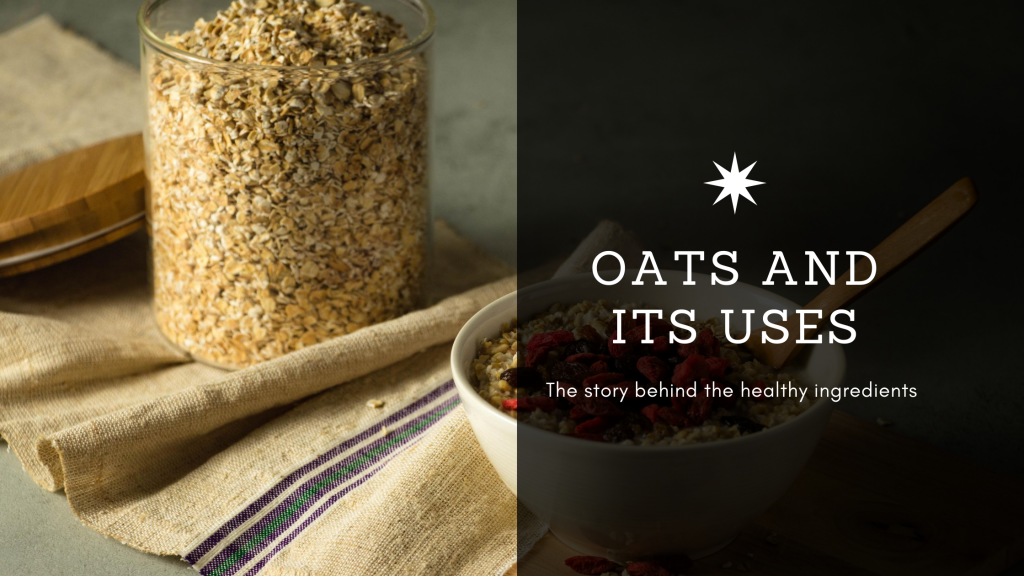
Oats – Avena sativa, is a whole-grain cereal mainly grown in North America and Europe. They are a very good source of fiber, especially beta-glucan, and are high in vitamins, minerals, and antioxidants. The oat is a species of cereal grain grown for its seed. Oats grow in fields like wheat and barley year-round. Crops sown in spring and harvested in August are called ‘spring oats’. Crops sown in September and harvested in spring are called ‘winter oats’.
What are the types of oats?
There are two main types of oats: Rolled and Steel-Cut. Both types begin as whole oats (groats), from which the outer layer (the hull) is stripped, leaving the fiber-rich bran, the endosperm, and the germ, which is home to vitamins and minerals, antioxidants, and healthy oils.
What is Rolled Oats?
When the whole grains are steamed and pressed flat with steel rollers known as Rolled oats. This process shortens the cooking time.
You can find three kinds of rolled oats in the market:
- Old-Fashioned Oats: The whole grains are steamed, flattened by the roller, and then flaked. You can use this to make granola and muesli as well as oatmeal. It is best to enjoy as oatmeal or add them to baked foods.
- Quick-Cooking Oats: The oats are cooked, dried, and cut, then rolled thin for faster cooking.
- Instant Oats: The oats are cooked and dried before being cut and then rolled thin. Instant being quicker than quick, instant oats are the fastest oats of all, though they can sometimes be gummy or mushy. Oats are flattened even more, so they cook even faster. This is a good choice for introducing oatmeal to very young children. Study the label of instant oats before purchasing, they can be less healthy than other types of rolled oats if sugars, salt, and other ingredients are added to the mix.

What is Steel-Cut Oats?
It is also known as Irish oats or Scottish oats. Steel-cut oats aren’t rolled. Steel blades slice them into coarse nubs, giving them an appearance like cut-up grains of rice. Steel-cut oats are less processed than rolled oats.
They take longer to cook than rolled oats, and their texture is a bit chewier. Beyond hot cereal, steel-cut oats are good candidates for cooking in stews and soups — they absorb less water than rolled oats. It is the best to use for adding to meatloaves or for stuffings.

Steel-cut is my favorite, but it takes the longest to cook. You bring the water and oats to a boil, turn off the heat, cover, and leave the pot on the stove overnight. The oats slowly absorb the water and become tender. Then all you have to do is heat through and serve with your favorite toppings.
Are oats gluten-free?
Technically oats are gluten-free since they aren’t a type of wheat, barley, or rye grain, the three groups of whole grains that naturally contain the protein gluten. Instead of containing gluten, oats have a protein called avenins.
Although oats themselves don’t contain gluten, they’re often grown alongside other crops.
The same equipment is typically used to harvest crops in neighboring fields, which leads to cross-contamination if one of those crops contains gluten. The sowing seed may also be impure, harboring a small amount of wheat, rye, or barley seeds.
Additionally, products made with oats are usually processed, prepared, and packaged in the same facilities as gluten-containing products.
Therefore, it’s unsurprising that studies analyzing regular oat products identified levels of gluten far exceeding the standard for gluten-free foods
What are the health benefits of Oats?
Oats are considered a better carb source because it has a lower glycemic index and they tend to contain more fibers than wheat or rice. If you are sensitive to gluten then you can’t eat wheat anyways while oats are good gluten-free grain. So it’s less about just oats, but more about anything with high fiber.
The carbs in oats are mostly starches and fiber. Oats pack more protein and fat than most other grains and are a good source of beta-glucan, a unique, soluble fiber linked to multiple health benefits. Fiber is great for digestive health. If you have chronic constipation issues, consuming oats every morning will be helpful. One cup of oats contains four grams of fiber. You can include fruits and nuts to increase the fiber value of your breakfast.
Oats can help improve risk factors for heart disease by lowering LDL cholesterol and raising HDL cholesterol. Oats and oatmeal can aid weight loss by helping control appetite and increase fullness. It also helps to improve blood sugar control, blood fat levels, and insulin sensitivity in people with type 2 diabetes
How to use Oats?
Oatmeal is chiefly eaten as porridge, but may also be used in a variety of baked goods, such as oatcakes, oatmeal cookies, and oat bread. Oats are also an ingredient in many cold kinds of cereal, in particular muesli and granola. Oats are also used for the production of milk substitutes “oat milk”.
One of the easiest ways to have oats is with some warm milk, fresh fruits, nuts, and seeds. You can even use coconut milk and sweet berries. Take a bowl of warm milk then add half a cup of dry roasted oats along with everything that your heart desires.
